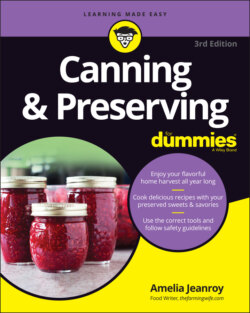Читать книгу Canning & Preserving For Dummies - Amelia Jeanroy - Страница 3
Canning & Preserving For Dummies® To view this book's Cheat Sheet, simply go to www.dummies.com and search for “Canning & Preserving For Dummies Cheat Sheet” in the Search box. Table of Contents
Оглавление1 Cover
2 Title Page
3 Copyright
4 Introduction About This Book Foolish Assumptions Icons Used in This Book Beyond the Book Where to Go from Here
5 Part 1: Getting Started Chapter 1: A Quick Overview of Canning and Preserving Appreciating the Benefits of Canning and Preserving Your Own Food Introducing Your Techniques: Canning, Freezing, and Dehydrating Holding the Keys to Canning and Preserving Success Chapter 2: Gathering Your Canning and Preserving Gear Keeping Basic Kitchen Tools at the Ready Canning Equipment Required Tools and Equipment for Freezing Food Necessary Tools and Equipment for Dehydrating Food Chapter 3: On Your Mark, Get Set, Whoa! The Road to Safe Canning and Preserving Dispelling Your Fears of Home-Canned and Home-Preserved Food Knowing the Acidity Level of Your Food Adjusting for Your Altitude Spoiler Alert: Identifying Food Spoilage
6 Part 2: Water-Bath Canning Chapter 4: Come On In, the Water’s Fine! Water-Bath Canning Water-Bath Canning in a Nutshell The Road to Your Finished Product Adjusting Your Processing Times at High Altitudes Chapter 5: Simply Fruit (Yes, a Tomato Is a Fruit) Picking and Preparing Your Fresh Fruit Fresh Fruit Canning Guidelines Chapter 6: Sweet Spreads: Jams, Jellies, Marmalades, and More Introducing Your Sweet Spreads Choosing Fruit for Sweet Spreads Getting Up to Speed with Fruit Pectin Setting Up without Adding Pectin Water-Bath Canning: The Key to Sweet Spread Canning Success Chapter 7: Condiments and Accompaniments: Chutney, Relish, Sauce, and Syrup Expanding Your World of Condiments and Accompaniments Chapter 8: The Art of Pickling Bring on the Brine A Few More Prep Tips to Ensure Tasty Pickled Treats Picking Pickling Equipment and Utensils
7 Part 3: Pressure Canning Chapter 9: Don’t Blow Your Top: Pressure Canning Understanding the Fuss about Low-Acid Foods Choosing Your Pressure Canner A-Canning You Will Go: Instructions for Successful Pressure Canning Disposing of Spoiled Products Pressure Canning at Higher Altitudes Chapter 10: Preserving Your Vegetable Harvest Selecting Your Vegetables Prepping Your Veggies for Pressure Canning Processing Tips for Successful Results Under Pressure! Canning Vegetables Using Canned Vegetables Chapter 11: Don’t Forget the Meats! Preparing for Pressure Canning Meats Canning Meat Cut into Cubes or Strips Canning Ground Meat Pick Your Packing: Canning Poultry Worth the Effort: Canning Fish Including Meats in Other Canned Mixes Chapter 12: Combining the Harvest: Soups, Sauces, and Sides with Beans Confidently Canning Food Combos Stocking Up on Soup Teaming Up with Tomatoes Rounding Out Your Meals with Beans
8 Part 4: Freezing Chapter 13: Baby, It’s Cold Inside! Freezing Fresh Food Defining Freezing Meeting the Spoilers of Frozen Foods Gearing Up to Fill Your Freezer Packaging Your Food and Filling Your Freezer Thawing Out Your Frozen Food Chapter 14: Meals and Snacks in a Snap: Freezing Prepared Foods The Whys and Wherefores of Putting Up Prepared Food Freeze Convenience Meals Now, Thank Yourself Later Save Some Dough: Freezing Breads, Cakes, and Other Treats Freezing Dairy Products and Nuts Making the Most of a Good Meat Deal: Freezing Meat, Poultry, and Fish Chapter 15: Freezing Fruits, Vegetables, and Herbs Mastering the Easy Art of Freezing Fruit Freezing Vegetables Like a Pro Freezing Fresh Herbs
9 Part 5: Dehydrating and Storing Chapter 16: Light and Nutritious: Dehydrating Food Setting Up for Food Drying Success Choosing a Drying Method Storage Solutions: Protecting the Life of Your Dried Food Chapter 17: Dehydrating a Variety of Delicious Fresh Fruit Putting Your Best Fruit Forward Navigating Your Fruit-Drying Experience Rehydrating and Enjoying the Labors of Your Drying Chapter 18: Dehydrating Vegetables for Snacks and Storage Vegetable Drying at a Glance Drying Common Vegetables Mixing It Up for Soups, Stews, and More Chapter 19: Drying Herbs Selecting, Drying, and Storing Common and Not-So-Common Herbs Getting Creative with Herb Cooking: Rubs and Blends Herbs for Teas Chapter 20: Helping Your Food Keep Its Cool: Cold Storage Spaces Cold Storage Must-Haves Exploring Your Cold Storage Options Following Simple Cold Storage Rules Preparing Foods for Cold Storage
10 Part 6: The Part of Tens Chapter 21: Ten (Plus) Troubleshooting Tips for Your Home-Canned Creations Jars That Don’t Seal Properly Jars That Lose Liquid During Processing Jars with Cloudy Liquid Dark Spots on Your Jar’s Lid Jelly with the Wrong Consistency Cloudy Jelly or Jelly with Bubbles Moldy Jelly Jelly with Very Little Fruit Flavor Glasslike Particles in Your Jelly Hollow, Shriveled, Discolored, or Slippery Pickles White Sediment at the Bottom of the Pickle Jar Food That Floats in the Jar Food with an Off Color Chapter 22: Ten Common Food Storage Problems and How to Solve Them I never use up all my stored food, and so it goes to waste I don’t know how much to preserve My family doesn’t want to eat the food I don’t have any more room and I am not done I don’t know what I have already stored I don’t know which preservation technique to choose I don’t know how to use the food I have preserved My preserved food looks weird I used up all the food that I stored I don’t know where I’ll store food if I start preserving it
11 Appendix: Metric Conversion Guide
12 Index
13 About the Author
14 Advertisement Page
15 Connect with Dummies
16 End User License Agreement
